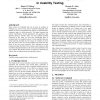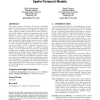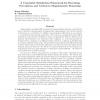521 search results - page 60 / 105 » Learning By Observation Using Qualitative Spatial Relations |
ACMDIS
2000
ACM
14 years 2 days ago
2000
ACM
Many sources of empirical data can be used to evaluate an interface (e.g., time to learn, time to perform benchmark tasks, number of errors on benchmark tasks, answers on question...
CVPR
2008
IEEE
14 years 9 months ago
2008
IEEE
To learn a new visual category from few examples, prior knowledge from unlabeled data as well as previous related categories may be useful. We develop a new method for transfer le...
ATAL
2006
Springer
13 years 11 months ago
2006
Springer
This paper presents a framework for robustly recognizing physical team behaviors by exploiting spatio-temporal patterns. Agent team behaviors in athletic and military domains typi...
JAIR
2010
13 years 6 months ago
2010
Diagrammatic reasoning (DR) is pervasive in human problem solving as a powerful adjunct to symbolic reasoning based on language-like representations. The research reported in this...
NEUROSCIENCE
2001
Springer
14 years 4 days ago
2001
Springer
Biological networks are capable of gradual learning based on observing a large number of exemplars over time as well as of rapidly memorizing specific events as a result of a sin...



